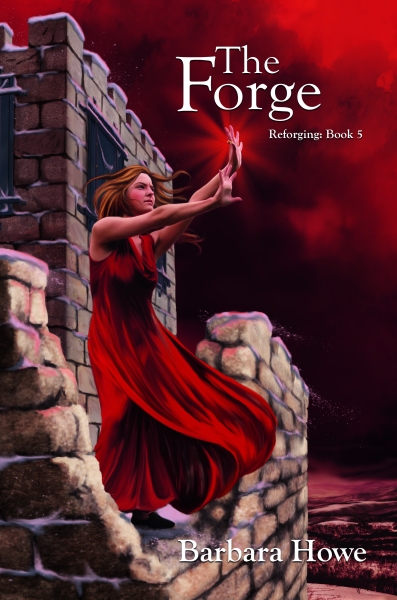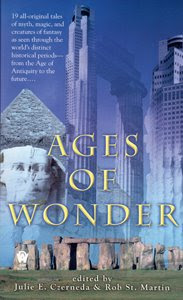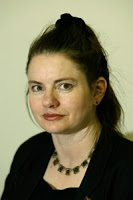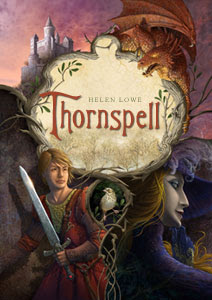
Lyn McConchie is a New Zealand writer who has been published extensively, especially in the USA, in a range of genres: science fiction, fantasy, horror, humour, and mystery. Lyn was crippled in an accident in 1977 and forced to take medical retirement in 1988. She now owns and runs a small farm near Norsewood, where she breeds coloured sheep and tends her free range geese and hens. I talked with Lyn abut her career, the many genres in which she has written, her collaboration with Andre Norton, and her view on the future of publishing.
Lyn, you began your professional writing career in 1991, with short fiction sales to the US magazines MZB’s Fantasy Magazine and Strange Plasma. What got you started in writing short fiction, and had you been writing and submitting stories for long before you made your first sale?
Tim, actually it’s all Greg Hills’ fault that I ever started writing at all. At the time he was the WARP editor. He suggested one day that he’d appreciate it if I could find time to do a few book reviews and I did, then I was asked for an article, and provided one. He said later that I could probably manage a short story or two for the magazine? And I did. Natcons here were running a short story competition by then each Natcon, so I started entering. Culminating in winning the last two that I’d entered, so a friend suggested that I should try selling some of my work. Being the eternal optimist that I am, I did. I looked up markets in LOCUS, and another friend mentioned a children’s magazine (KIWI KIDS) that had just started here. So I sent out three stories, one each to MZB’s Fantasy Magazine, Strange Plasma and Kiwi Kids. I also offered poems to another market in the States. All three stories sold to my pop-eyed astonishment, and while the poetry magazine didn’t accept the poems I offered, they too found homes later and elsewhere. So no, I hadn’t exactly been submitting stories long before I made my first sale, and I’d only been writing fiction at all for about five years.
You have published 16 novels – which impresses me tremendously! How did your first novel come to be written and published?
Um. It’s 24 books now. I had a mad binge on acceptances last year and sold five, with another so far this year. The first however was a surprise. I’d been writing long letters to overseas friends about my farm and mad farm animals for several years. When at a writer’s group with friends I was asked to read one of the episodes, I did so and it was pointed out that this could be publishable. There was at the time a quarterly magazine here that specialised on the subject of lifestyle blocks/farmlets, and I offered them four humorous true-life articles based on my letters to friends. These were accepted, and some months later the editor came back to me asking if I had sufficient material for a book. I did, and the publisher for whom he worked accepted that. It appeared in May of ’93 and has been in print ever since. The series transferred to AVALOOK PUBLICATIONS in Australia in 2002, and since then it’s gone to four books with a fifth sold and scheduled to appear shortly
The next two books were sold in the UK from a small publisher. Again, by something of a fluke and originally because of an argument with a writer friend. To prove my point to her I sat down and wrote a 45,000 word book in three weeks. I won the argument and later Rod Marsden in Australia, who knew about this book, told me of a UK publisher who was taking that sort of work. I offered, they accepted, and asked for another, which I also wrote in around three weeks and sold to them.
Many of your novels have been written and published in collaboration with the famous science fiction and fantasy writer Andre Norton. How did this collaboration come about?
Andre was an old friend whom I’d known for some time before I began writing. When I did she encouraged me hugely, read some of my short stories, and was always very supportive. How the first book arose from that is a very long story, but its acceptance and publication was on her initiative.
It’s evident from your website that, for your books listed as co-written with Andre Norton, you did most or all of the work, either writing the book based on a brief outline she provided, or writing the book from scratch within a universe she had created. How do you feel now about the pros and cons of such an arrangement, where a better-known writer lends their name to a project mainly or wholly written by an initially less-well-known writer?
KEY OF THE KEPLIAN, CIARA’S SONG, THE DUKE’S BALLAD and SILVER MAY TARNISH, were all written completely by me with no input from Andre apart from approval. The three Beast Master books arose from a conversation when I was staying with her in 1995. She said that she felt she was out of ideas for the series, had never wanted to continue with it, but knew it was still very open-ended. Would I like to continue with it? There and then while eating breakfast we discussed possible ideas that I wrote down. These became two outlines (for the next two books,) one of almost two pages, one of one page. I can’t remember for certain whose the ideas they were, we were tossing them back and forth, but I believe the major plotlines of alien insects and the Thieves Guild circus both came from me. The third Beast Master book I wrote with no input, but Andre liked it, particularly my reversion to Beast Masters returning to be part of First in Scout Survey teams again.

In addition to the novels, you have had plenty of short stories, poems and non-fiction published. All that writing takes a lot of dedication. How do your schedule your writing day, and do you find it hard to fit in writing with your other commitments?
Every cloud has a silver lining. Being crippled, and not being able to work 9-5, I can write at any time just so long as I’m not in too much pain to concentrate. I’ve averaged two books, about 12 short stories, plus maybe 3-4 articles/opinion pieces, and a handful of poems every year. That adds up after 20 years. Since my other commitments are mostly the farm and animals, and it’s a very small farm, I manage without too many problems. One of my main advantages is that I don’t have problems if I’m interrupted. I can just return, read the last sentence and I’m away writing again.
You live on and run a small farm, and you’ve had a number of books about rural life published in the Farming Daze series. Do you find writing these books a refreshing change from writing the big fantasy novels? Does writing them present its own, separate set of challenges?
These books write themselves. Any time something peculiar or amusing happens on the farm I write it up. That goes into letters to friends, but at some stage when there’s enough material, I sort it out into the next book. Since it isn’t fiction it’s a huge difference from writing fantasy – although some of the farm stuff can cross over. For instance, the coloured sheep flock in CIARA’S SONG and DUKE’S BALLAD are my real sheep. And Andre borrowed my tales of them too for her book, THE HANDS OF LYR, where they became alien herd animals.

I hear that your current writing project is a Western. What got you interested in writing in that genre, and what’s the market like for Westerns these days? What are the key things a good Western needs?
Well, I like a good western, and one day I sat down and wrote one for fun. I then found that the market had gone south as publishers now didn’t want the standard shorter work. They wanted 120,000 word blockbusters and mine was around 70,000. So I filed it. Then I found that a USA publisher to whom I was selling short stories for her magazines, also had a western imprint. I offered, she accepted, and SOUTH OF RIO CHAMA appears later this year. What does a good western need? Same as any other book I guess. Good plot, character development, realist dialogue, and something that moves right along. Oh, and it helps if you are an expert in the Old West. I’m very definitely not, so it’s a learning experience.
There’s a flood of news at the moment about changes in the publishing industry, under the twin impacts of the recession and of changes in the ways books are produced, distributed and marketed. What changes have you seen in the publishing industry since 1991? Are you optimistic about the future of publishing in general, and science fiction and fantasy publishing in particular?
There’s been a huge impact on the market with many smaller publishers going into POD and download and the market expanding without the need to warehouse enormous quantities of printed copies. I would always prefer to see my books in print, the POD/download duo I find acceptable, but I don’t think I’d want to sell a book to a publisher that didn’t have that option. I’m old fashioned perhaps, but I like a book I can read in the bath, in bed, or while waiting in a car for friends. And no, I don’t find that the kindle cuts it. And I have the feeling that this won’t change for me.
Apart from the Western, what other writing projects do you have on the go?
I’m just waiting to see the cover for the new non-fiction book from Avalook Publications. RURAL DAZE AND (K)NIGHTS, is due out in a couple more months and the cover is being done by my regular artist who lives near me.
I have some revision still to do on the other book from Cyberwizard Productions. That’s SUMMER OF DREAMING, a supernatural fantasy for older children/YA and set in New Zealand. Sadly I couldn’t find a publisher here, so it was offered to Cyberwizard who liked it.
I’m gradually putting together a short story theme collection of SF stories I hope to offer a publisher late this year.
I’ve just completed first draft of a new fantasy, and at some stage must sit down and write several linked short stories that are harassing me.
I’m also expecting to have revision to do this year on the book sold to TOR, (THE QUESTING ROAD, set in my own world of Aradia) and my SF/disaster novel set in NZ, and sold to Daverana Enterprises, (VESTIGES OF FLAMES). With all that cleared I’ll begin on the next Aradian fantasy which I hope to have done by Christmas if none of the above holds that schedule back too far.












